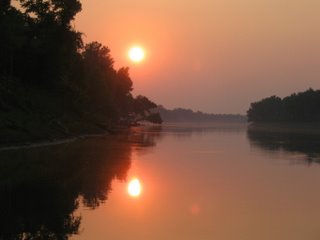The World Outdoors

Moonrise on the river last month.
Those of us who remember Art Linkletter remember that he had a TV show called Kids Say the Darndest Things. This was located, in time, somewhere deep in the recesses of the last millennium. And on his show they did, sometimes, say things that were surprisingly wise.
This week I was in the company of three grandchildren, ages 11, 11 and 9. It had been a kind of slow afternoon for them, both Carolyn and I had to be doing some things on our own that day. When I came into the living room, all three of them were sitting on couches looking very bored. I guess I kind of lit into them for not taking advantage of being in a place where the outdoors is where things are happening, rather than indoors as they are used to in the city. I pointed out this, and I pointed out that, and I guess I concluded with saying that the WORLD was outside the doors, and they could at least have spent time on the big ten-foot-wide porches we have in front and back of the house. Anything to get outside and take in some of the huge natural setting that was being offered to them. I guess I was a little upset because I thought I was offering the world and they were inside being bored.
They listened more or less politely to me, as I proved once again that in their limited experience their grandfather is somewhat strange. After this they kind of uneasily went about doing things indoors, not to let on that I might have said something that might have some merit. But, about an hour later, I was in the kitchen and overheard the following short exchange. “Why don’t we go outside?” then “What’s outside?”, then, “The world [pause], apparently”. I started laughing and I still can’t get it out of my mind. What kids! I love them all. After all this we went outside and they learned to identify poison ivy, and how to handle a rifle.
 The walking sticks are frequent inhabitants of my birdhouses. Since they are always coupled, as shown, I would imagine they value the privacy of the dark little box, or maybe just the darkness.
The walking sticks are frequent inhabitants of my birdhouses. Since they are always coupled, as shown, I would imagine they value the privacy of the dark little box, or maybe just the darkness. The river is at 2.9 on the Butte La Rose gauge and is showing .5 foot tidal fluctuation now. The Ohio and Mississippi are both showing small rises, and that’s a good thing. It should at least hold things from dropping even lower.
Rise and Shine, Jim














































